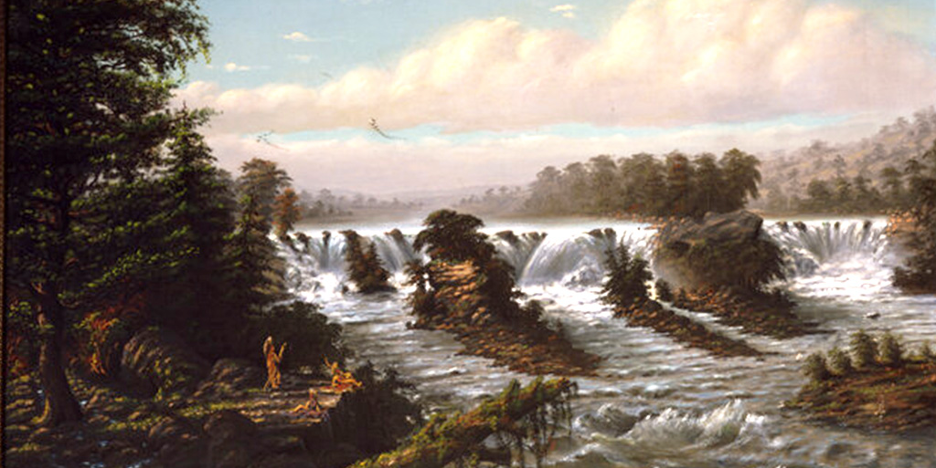By David Wiggins – Historian & Former National Park Ranger
Minneapolis – Village of Saint Anthony | April 3, 2025
Making history with the Power of the Falls. Technological innovation spanning over a century continues at Saint Anthony Falls with a new emphasis on environmental stewardship. A park ranger’s perspective on an entrepreneur finding success at the falls
It had been called the waterfall that built a city, but the Saint Anthony Falls story is even bigger than that. Some places are simply more important than others in history and the falls is one of those places. Just like big river systems, in the flow of history there are connections and confluences that concentrate relationships in a way that makes significant change over a larger geography. It is in these places that what seems like lucky coincidences happen and where new relationships generate innovation and open up creative options for growth.
A Historian’s Perspective: Living the Story
My work was part of a larger public and private partnership effort that resulted in a transformation of the district from one of the abandoned buildings to the fastest growing part of the city. The time was ripe and with state, local and federal funds over the decade we saw the opening of the Stone Arch Bridge, interpretive signage on the trails, looping in the power plant tours and many successful adaptive reuse projects underway.

I was concentrating on finishing the plans and exhibits for Mill City Museum, when I was recruited by the National Park Service. I became a supervisory national park ranger with the job of developing the Mississippi River Visitor Center and exhibits in partnership with the Science Museum of Minnesota. I moved to work again in St. Paul, but I didn’t have to abandon my friends at the falls. The national significance of the history represented by the district and the three national monuments was one reason the park boundary included these sites. Part of my job continued to be working with our partners in Minneapolis who were telling this national and international story at the falls within our park.
Meeting Bill Neuenschwander: A Modern-Day Millwright
It was in this capacity, as a national park ranger, that I first met Bill. His ambition of helping people around the district with Segway tours seemed very promising but I had experience with poor tour guides teaching bad history, so I was cautious at first. Soon I saw his commitment to getting the facts straight and took some time to show him around the complicated mix of history there. In his enthusiastic plunge into this story, I recognized qualities that reminded me of the early mill developers: attention to detail, a smart eye for potential profits, mixed with a commitment to building something of quality that would work efficiently. He had that same critical eye on how something could be done better. He shared their ability to work with others to get to a bigger vision.

Inspiration from the Past, Vision for the Future
We talked about the big systems thinking that made fortunes for James J. Hill, and the strength of his simple idea of building a quality railroad for shipping big loads efficiently instead of the old focus of pumping up stock prices. I remember when we talked about Hill building the Stone Arch Bridge for the long term as we walked out the restored bridge to see the tail raceways from the Hennepin Island hydroelectric plant, generating 12.5 Megawatts. You could hear both the turbines inside and the wheels inside Bill’s head as he was calculating how he could run his Segways off power from the falls. I thought of Hill finding a way to connect the dots and knew that Bill was a kindred spirit.
We talked about the great Austrian-born civil engineer William de la Barre and his work getting the Corps of Engineers to build reservoir dams on the lakes feeding the river from northern Minnesota and how that made it possible for the streetcar system to use hydropower from the falls. We talked about the first commercial hydroelectric generating plant on the other side of the bridge and how all these technological innovations were happening because of the people who were here with the good ideas to do it and the resources and patience to make it happen.
I could see then that the entrepreneurial character in Bill resembled the character of the Yankees developers who developed the power of the falls for lumber and flour milling. (The descendants of these early millers are similar. I had the pleasure of meeting some in the course of fundraising for Mill City Museum.) Bill’s enthusiasm for the future, with a vision for what could be done to make it happen, continues to be surprisingly common around the falls. A lot of history is luck – just being in the right place and at the right time to make the right choices possible, but not all of it is due to chance. Much of it is made by people moving towards a vision for what the future should be.

History Rhymes at the Falls
People like that seem to get attracted to this special place, like they always have been. Innovators like Sean Sherman, starting the indigenous Food Network and the Owamni restaurant, and the research hub of the Saint Anthony Falls lab and nearby University of Minnesota continue the tradition of growing something new here. The idea that history doesn’t repeat but rhymes is connected to the idea that places keep a certain character over time, even as they change through history, just like a person when they are old will resemble their younger self. Minneapolis is older now and much changed from years ago but still familiar as a place that can bring a good idea to fruition.
20 Years of Green Power – First in the Nation
In history we often make much of the first instance of something, or the fullest glory of something. The historical significance of the 20th year of providing green power to the first fleet of electric vehicles is significant for being the first, just as we consider that it was important in history that the first commercial hydroelectric plant was built at the falls. But this “first” in history catches our notice now because of how important hydroelectric generation became over time. The enduring change connected to that one time and place in history is now easy to see, but at the time it was just another venture. Only in retrospect do we see that what was started there became something very important.

Wheels of Change: From Rails to Segways
Twenty years is a long time in a business, but a short time in history. Only now are we beginning to see that most of our transportation power will in time likely have to come from renewable energy sources. Only in time will the full change towards that way of doing things be connected back to the pioneering entrepreneurs that made it happen. When I look for what rhymes in history, I seen Bill rhyming with Hill in more ways than one. Hill never foresaw that Segway wheels would replace trains wheels on his Stone Arch Bridge, but he would have approved of Bill’s approach to thinking about the big picture and finding ways to make a new future.

David Wiggins, retired national park ranger and historian who has been a friend of St Anthony Main Riverfront Community


